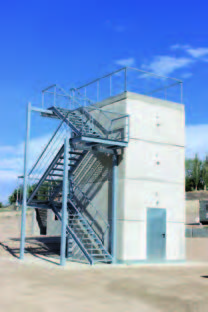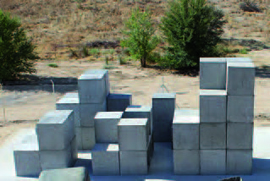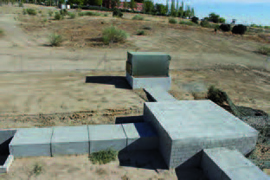- Home
- Feature Articles
- Full article
Health in Combat
Tuesday, May 19, 2015
Number: 011
The track and the classroom of the Medical Brigade

Tower: It has an external staircase and a trap door on top, and is used to simulate rescues at heights.

Mountain of Blocks: El reto es subir y bajar con un herido por un terreno abrupto y lleno de desniveles.

Tunnels: They are shaped like a cross and test the ability of the medical teams to operate in small spaces and with limited visibility. It has a sound system that reproduces noises and screams; smoke can be also added. Mobile porthole cameras follow and capture every movement of the personnel from a container outside the tunnel.
At first it is not easy to notice that the health training track of the Medical Brigade at the “General Cavalcanti” military barracks was built for sport training purposes. An experienced observer might find a clue of this past in the small walls that separate the lanes in what is now a barbed-wire course, which are of the type normally used in balance training. But little more than that, not only because the remodeling of the track has been quite radical, but also due to its dynamic character, which makes it easy to change its features depending on the needs of the personnel being trained.
The result is a 19-hectare space allocated to the training of medical personnel in all questions related to combat. It has nearly thirty separate elements (some of them, still in the works), out of which many different scenarios can be created to reproduce the conditions of almost any area of operation and with different levels of difficulty for the trainees. The aim is that “they become able to cope in any scenario”, explains Medical Lieutenant Colonel Pilar Frutos, who is in charge of the track. Lt Col Frutos is an expert in the field of medical emergencies and has taken part in seven international missions. She has devised herself many of the elements in the track and strives daily to continue to improve it. Almost like a second-hand dealer, she has been able to rescue several decommissioned vehicles (including some that used to belong to the Civil Guard, whose cooperation she appreciates). As well as several cars, she has a BMR and is expecting a tank, the fuselage of a helicopter, a plane tube and some old railways and carriages. She confesses that the track has everything she has ever wanted but never had – until now.
A facility for the whole of the Army
The track was initially conceived to train only the personnel of the Medical Brigade. However, in 2015 the Brigade will become a Training Unit of the Army (which was only the case of the Field Hospital Group), under the command of the Logistics Academy. As a result, the track will be part of the Academy’s resources for the training courses it offers: Auxiliary Nursing, Pharmacy and Veterinary, Medical Support in Combat and Medical Technician. So although it will continue to serve its original purpose, it will be used by all other units of the Army – without excluding the rest of the Armed Forces, or even civilian organisations.
A classroom has been set up next to the track to provide theoretical training as well as dummies and all kinds of simulation devices. These resources, combined with specific equipment, give the trainees the patient management techniques they need (insertion of a venous or respiratory catheter, chest decompression, minor surgery, fracture stabilisation, etc.). The plan is that the track will be divided into boxes, recreating the environment of the medical units deployed in the theatre of operations.
A dose of reality
In order to provide conditions as similar to reality as possible, a group is being trained in active simulation to interact with the medical teams being trained at the track and to re-enact as realistically as possible injuries caused by firearms, burns or NBC agents. Real shrapnel has even been collected from exercise areas to be placed in the demining scenario and inside wounds or fractures.
All sorts of combat situations will be reproducible in the track. For instance, those attending a course on 10th April had to deal with a situation in which a convoy was hit by an IED and ambushed and, as a result, both the driver and the female co-pilot of the attacked vehicle were injured in varying degrees.
ARMY UNITS
- Araba Álava |
- Albacete |
- Alicante |
- Almería |
- Asturias |
- Ávila |
- Badajoz |
- Barcelona |
- Burgos |
- Cáceres |
- Cádiz |
- Cantabria |
- Castellón |
- Ceuta |
- Ciudad Real |
- Córdoba |
- A Coruña |
- Cuenca |
- Girona |
- Granada |
- Guadalajara |
- Gipuzkoa |
- Huelva |
- Huesca |
- Islas Baleares |
- Jaén |
- León |
- Lleida |
- Lugo |
- Madrid |
- Málaga |
- Melilla |
- Murcia |
- Navarra |
- Ourense |
- Palencia |
- Las Palmas |
- Pontevedra |
- La Rioja |
- Salamanca |
- Segovia |
- Sevilla |
- Soria |
- Tarragona |
- Santa Cruz de Tenerife |
- Teruel |
- Toledo |
- Valencia |
- Valladolid |
- Bizkaia |
- Zamora |
- Zaragoza



